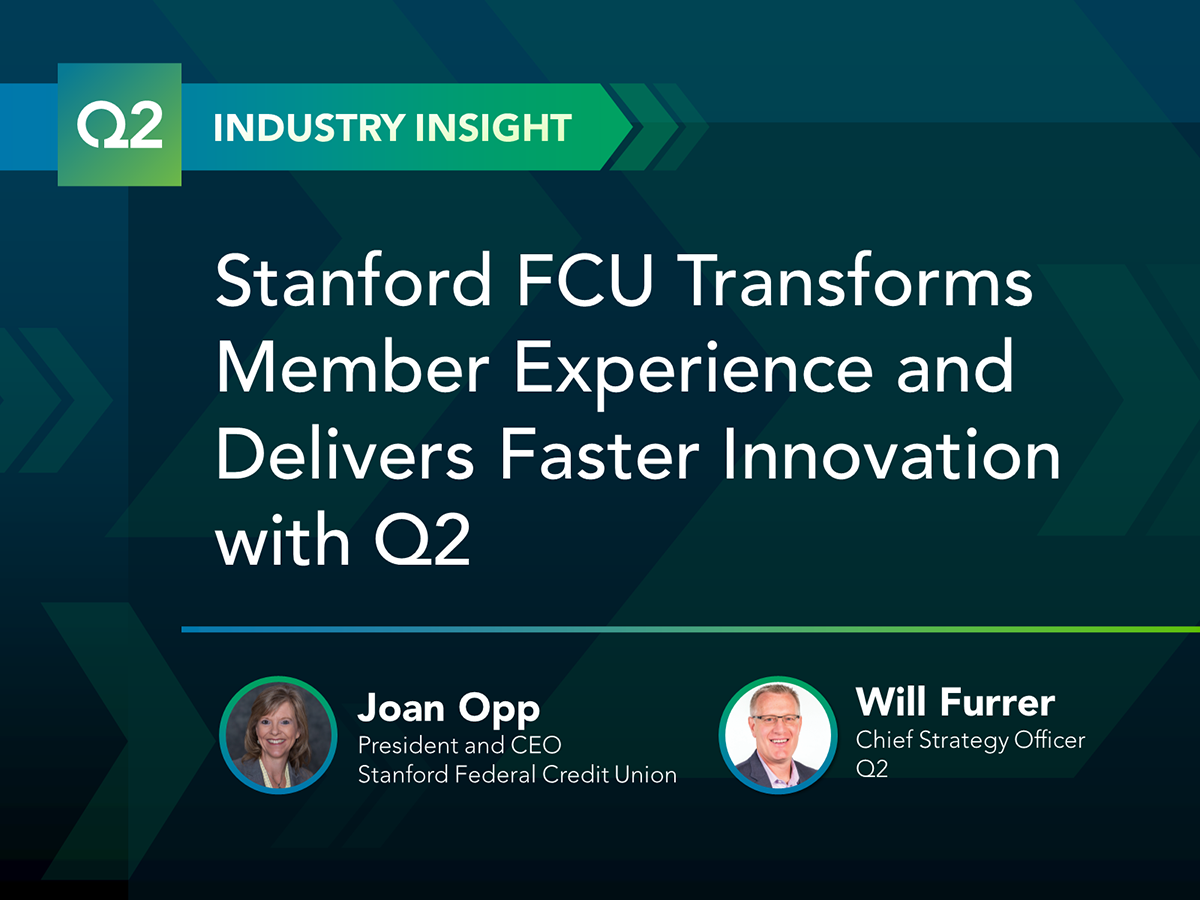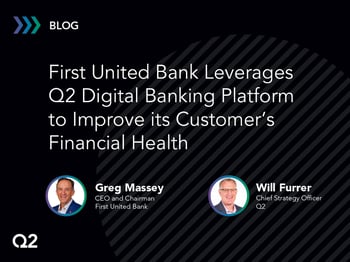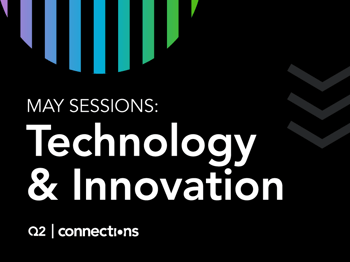This is a special edition of Q2’s Industry Insight Series with Stanford Federal Credit Union.
Q2 Chief Strategy Officer Will Furrer sat down with President and CEO Joan Opp who talked about how technology is impacting the credit union industry, the importance of staying ahead of the innovation curve and how to continue to deliver new features to a tech-savvy membership.
What follows is a transcript of the conversation, edited for flow and conciseness:
Will Furrer (WF): I'm here today with Joan Opp who's the president and CEO of Stanford Federal Credit Union. Thank you so much for taking time to speak with us today.
Joan Opp (JO): Anytime Will, it's always a pleasure.
WF: I wanted to ask a couple of questions: You serve on a lot of boards. You have worked in this industry for a long time. Can you talk to me about what you're seeing in the industry and the role that technology is actually playing to change business in the credit union space?
JO: For us, technology has become an everyday topic, particularly here in Silicon Valley. Stanford FCU serves members from the Stanford community, as well as many major tech companies in the area: Google, Facebook, Tesla, VMware. So, our members like technology. They use it every day. They live and breathe it.
With every year that goes by, we're becoming more and more a technology company that just happens to do banking versus the other way around. So, you watch what's happening in the fintech world, and I think as a traditional financial institution, we have to be moving in the direction that the fintechs are moving or we’ll get dis-intermediated.
WF: When you think about the interviews you do with your members and your Board of Directors, there's a lot of push to bring new ideas into your digital banking platform. As an example, international wires. Tell me about how folding new technology into the platform is really a game changer around customer sentiment.
JO: When we look at how members are transacting, there's two different types of feedback: There's feedback people give you directly because they write you a note, or fill out a survey or make a comment. Then, there's feedback we get indirectly by watching member behavior.
International wires is a great example of how we watched behavior and saw traction with our members using our new service. For us, that happened to be TransferWise.
Our members were independently using TransferWise, so we took the opportunity to reach out to them directly. We learned they were interested in natively integrating their feature into our online banking platform. And the three of us – them, us and you – worked together, resulting in the first integration TransferWise had with a U.S. financial institution.
Now, after the integration, our members were able to execute their international wires faster and significantly more efficiently when we took third parties like Wells Fargo or Western Union out of play. At first, our members didn't even notice the efficiency and execution. They just liked how fast it was. But then, the value came second, and that became a big thing.
The other feature we integrated, in partnership with Q2, was card controls. So now members can set notifications, they can set limits, they can go in if they can’t use their cards and are wondering if it was stolen. They can temporarily stop transactions, and then, turn them back on. These types of things go a long way in partnering with our consumers.
WF: When you think about the ability to fold these new ideas in, did you think you’d have the ability to have done this five years ago or even eight years ago, when you started with Q2? Can you talk to us about that evolution that you've seen in a company like Q2 and also in the industry? Can you share how difficult innovation has been in the past for credit union executives like yourself?
JO: The evolution that I've seen over five to six years in talking to our teams, talking to your teams, and talking to other partners, is that the tools that make these integrations more seamless are getting better and better. We now have the software development kit (SDK) tools. We have other application programming interface (API) tools that weren't available to us five or six years ago. And, quite frankly, fintechs are getting better about integrations also. We've been able to do some really exciting things and we have a lot more we'd like to do that we're continuing to talk about.
WF: And now with companies like TransferWise – now called Wise. Essentially, taking a fintech and embedding that fintech into your digital app, the concept of the embedded fintech is something that’s come to life, is that right?
JO: Absolutely. We have people who say they would rather use TransferWise – Wise – from within our app versus going to the legacy Wise app. They’re opting to stay on our platform because they’re already on it and, it's actually just a little bit faster because of the way it’s embedded, which is fabulous.
WF: Great. It allows you to maintain your brand and deliver great service.
JO: It's a win, win, win. Wise is happy with it. We’re happy with it. Our customers are happy with it. I think those kinds of partnerships, and the ability for our online banking provider, our core banking provider, to be so agile in these partnerships, is critical to financial institutions like us to be competitive in two years and four years and six years.
WF: Right. I think you bring up a great point. We talk about characteristics or qualities of an organization that can be a long-term partner. Can you talk about some of those qualities that you are looking for, that you're trying to build within Stanford FCU and that you're looking for your partners to bring to the table? Whether it’s speed, agility, vision. What are some of those qualities that you look for? As I mentioned, you serve on a lot of boards in the space. What are some of the foundational elements you see in a successful partner?
JO: First and foremost, we look for partners that will help us remove friction from the process. We're good at banking. We're really good at providing high-value financial products. We're not a technology company, even though I said we've become more and more so. We need partners that can create the user experience. To make it seamless.
You can't partner with everybody, right? So, we look for partners that are solving a pain point we have. I think one thing we’ve learned through the pandemic is that some of those pain points became clearer because more and more people who might have been resistant to trying technology in the past were almost forced to try it.
So now you have people that maybe aren't quite as technology adept as the people that were quick to try it. If I'm quick to try it, I'm probably a little more savvy and I can get through some of the bumps. But now you've got people like, ‘well, it's probably not good for me to go into the credit union; let me do this online’.
So, some of those pain points become clearer to people a little less tech savvy, and now we need to solve those pain points. We need to make it as user-friendly, as smooth as possible. And that's the kind of partners we look for.
WF: Right. We really appreciate the partnership and all the great ideas that Stanford FCU continues to bring to us. Thank you for driving us in those directions. When you think about the next several years, and you think about where the industry is headed, do you have any main buckets, or areas, where Stanford FCU is focused?
JO: What we are looking at in the near future are things like digitally issuing our cards and presenting, through online banking, the data for the new card immediately, so people don't have to wait five to seven days to start using their cards. That technology's out there, but it's not widespread yet.
We're also working on what we're calling a lightning loan. We can bypass the consumer loan origination system and give an immediate pre-approval, so, Will, we would know you're pre-approved for $20,000, for example. Why should you have to go through a loan origination system and wait 24 - 36 hours to get funded – which, by the way, in the old days was fast?
People want it now. I want to present that through our online banking and let users say, ‘yes, I want it.’ I want them to have it in seconds. To bypass that system. Create the loan. Fund the money. Boom. Will, you got the loan. You can go buy that car. We're working on the phrasing " lightning loan" to really make it immediate.
Also, we're improving the online account-opening process. We have it and it works, but can it be better? That's the first interaction that we have with a consumer, and it needs to be really, really smooth.
WF: So, from your chair, when you think about what has happened over the last several years, as well as what happened with the pandemic, it's really changed the credit union from thinking about digital banking services to really the entire credit union being digital. Is that a fair statement?
JO: It's very fair. It's consumer-facing, but also behind the scenes, right? Digital isn't just a user experience, it's a process experience. When we make the process better using technology, then the entire experience gets better.
WF: When you think about resource allocation as far as budgeting, are you moving more around changing the credit union itself and less to actually running the credit union – as you think about technology for those two purposes?
JO: The answer's easily yes. We tend to be different than some of our peers in that we’ve always competed more vigilantly. We have five branches. I can get to all of them in an hour and a half. They're all right here, yet we have members in 48 of 50 states. We have mortgage loans in 48 of 50 states. We probably have members in all 50 states.
If you just looked at deposits, at my top 25 depositors, 15 of them are out of state. But they can effectively and efficiently use Stanford FCU because of our digital solutions. Our solutions have got to continue to be up to date. They've got to continue to meet those expectations. As long as they do, we'll continue to serve those customers.
WF: That's great. Is there anything else that you wanted to close with? Anything that I didn't cover?
JO: I would say, first of all, that I think the things that we've been able to do over the last three years and our partnership using our online banking, have been phenomenal. I would love to see that continue over the next three years.
We're heavily focused right now on our student population. Providing services to students that traditionally they don't get. A great card, a great online experience, so that as they graduate from a place like Stanford, they never need to move their banking.
I'll tell you one more story: We do a lot of work with Google. And we have a lot of Google employees that have their accounts at Stanford FCU. A lot of that is because the initial digital experience that they had. I’ve had more Google employees tell me, ‘my first account in the U.S. was with Stanford Federal Credit Union, and I don't think I need to do my business anywhere else.’
That's a lot of pressure to continue delivering that experience, but I'm actually excited about it. Just this morning, I looked at the list of the things we want to do to differentiate ourselves with our team. And I think it's going to be a lot of fun. So, I'm looking forward to it.
WF: That's great. One last question for you: tell me about Access and talk to me about that relationship and how you see the relationship with Q2, if it's different than what you have with some of your other partners.
JO: We don't use the vendor term with our key, key partners, right? Q2 is in our top three key partners. I think the relationship we’ve had with Access has been, ‘if I need to reach you, I can reach you.’ We preach that you can't complain about a partner. You have to manage the relationship.
I think as Q2 has matured in recent years, my team is actually really positive about the relationship and I think there's excitement on both sides. We come in with an opportunity and say, ‘hey, what do you guys think about this?’ Then you guys come back and say, ‘wow, we haven't done that before, but why don't we do it?’ And then we're able to do it. And that work can be shared with others which is, I think, a great thing.
So, I think our team has appreciated the evolving partnership that we've had with Q2 over the last few years. And I would also say, let's keep it going.
WF: Well, absolutely. Thanks so much for sharing your views on the market, technology, consumer adoption and expectations, and our partnership.
JO: Absolutely.
For more information on Q2, visit www.Q2.com.





